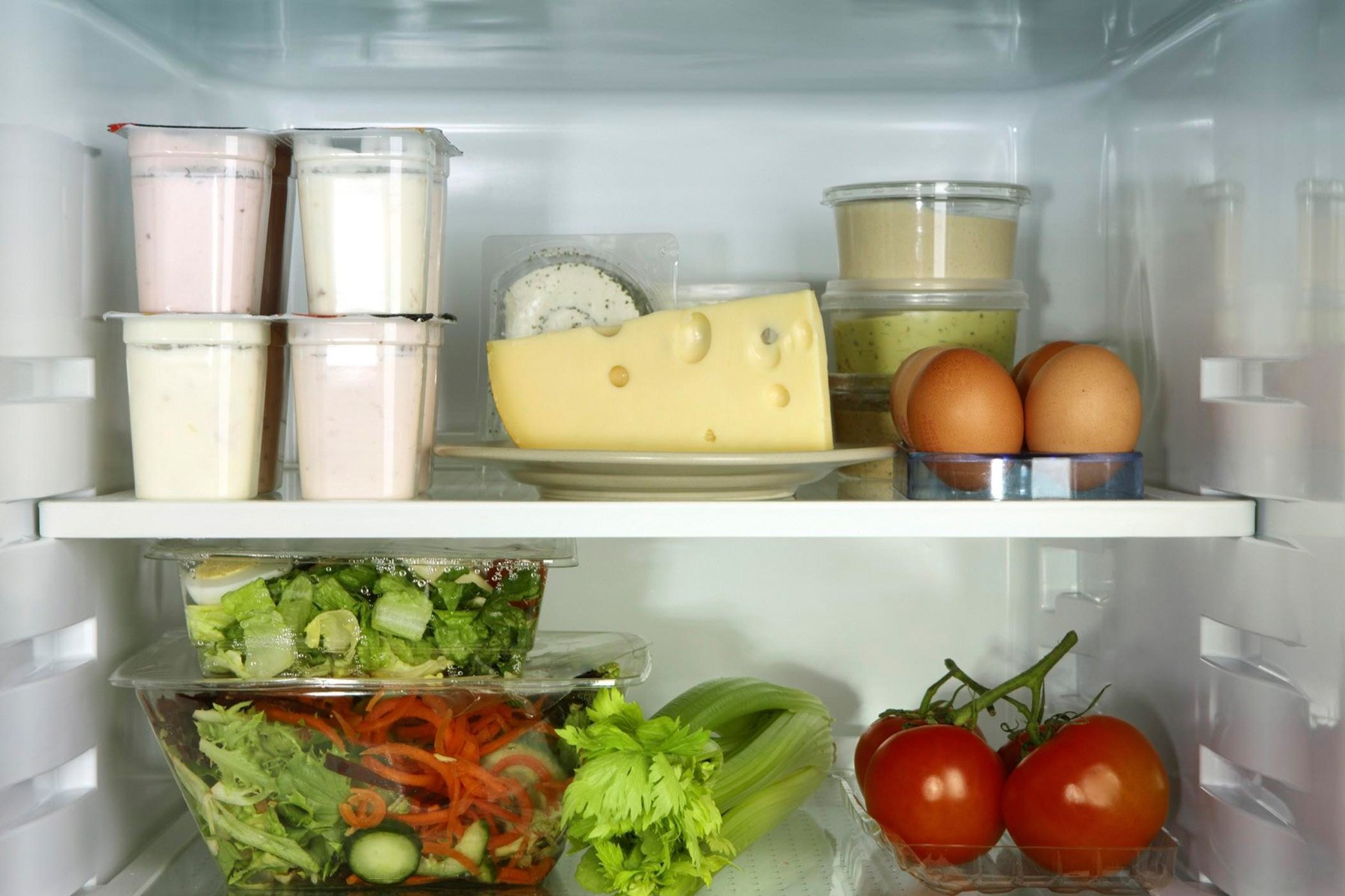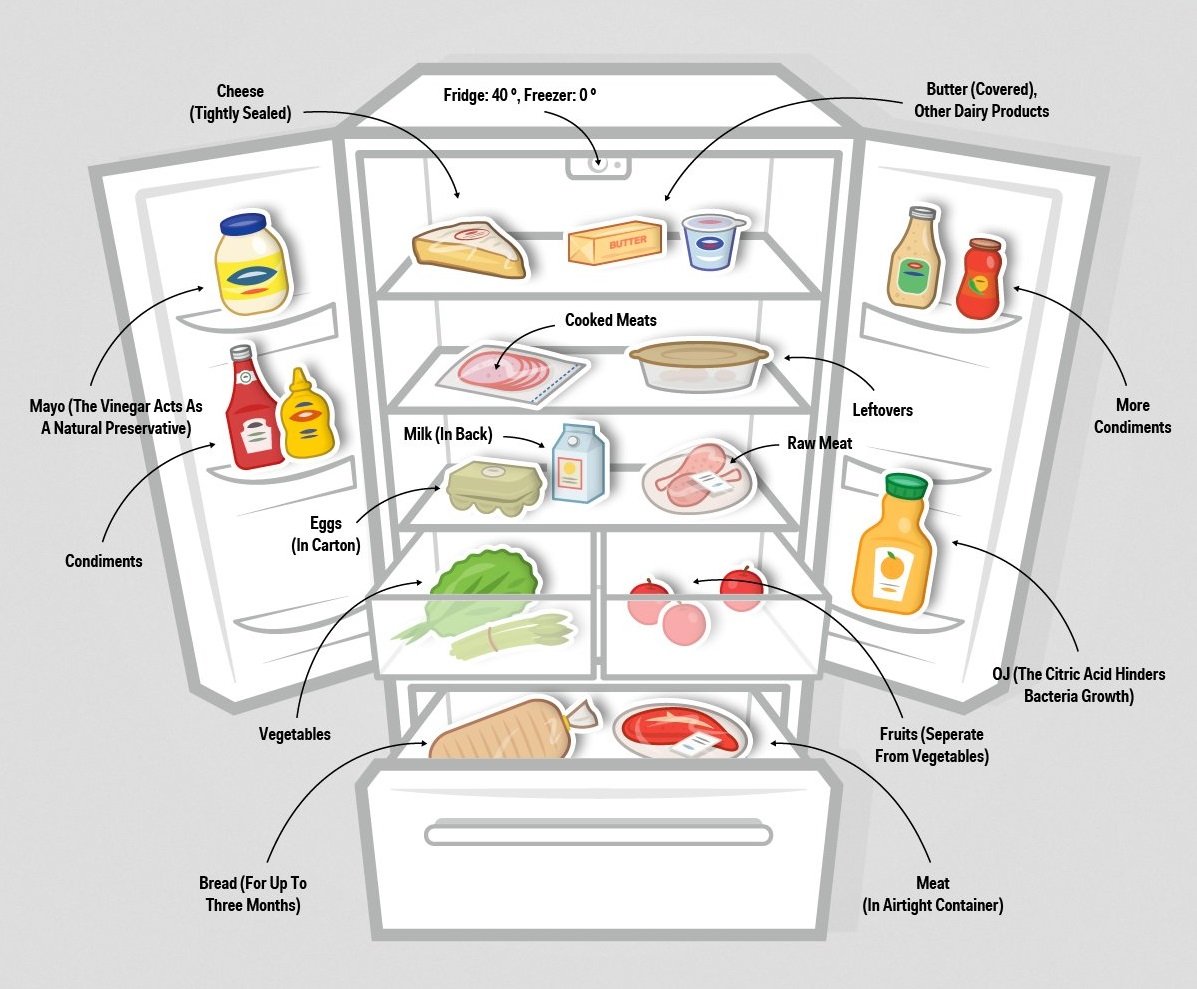How to store products in the refrigerator: on what shelves and in what table
The variety of products on the store shelves does not leave anyone indifferent. I do not always think about the provisions with whole trolleys, we don't always think about how long the next yogurt or banana will have to lie. What is not eaten, expired or disappeared, gets straight into the trash can, together with spent on it. To avoid such losses, you need to know how to store products in the refrigerator with maximum benefits.
We operate the refrigerator correct
There are some rules for storing products in the refrigerator, most of which are spelled out right in the booklet application to this home appliance:
- do not put hot in the refrigerator;
- tightly close the door to avoid the loss of temperature and overheating of the refrigerator;
- if you have a fridge with the NO Frost system, it is also necessary to defrost completely (together with the freezer) at least once a year;
- cropped watermelon, milk and other products that create condensate when cooling - cover with a lid or food film;
- carry out a revision of products weekly, throwing overdue, fired and proceeded;
- after the revision, wipe the refrigerator with a soap rag to destroy the smells and harmful bacteria.
What is the meaning of these rules - the right exploitation will support equipment in due state. And this will provide products to the necessary storage environment.
What to store products
Proper storage of products in the refrigerator implies a separate packaging, due to which:
- smells of different products will not be mixed and soaked;
- the top layer of food will not be dreamed and its appearance will remain original;
- freshness of dishes will continue longer.
Once you brought home shopping and disassemble them, you need to get rid of plastic bags - they are intended only for transportation. Special food packages can be used for storage of vegetables and fruits. The rest of the products are shifted into a new packaging.
But the packaging must be able to choose. You can store products in special food containers: cheese, salads, butter, fresh berries; In such plastic boxes, vegetables and fruits frost well. Their ergonomic form allows you to put many different products on the shelves, they are easy to wash and comfortably fold into each other, if not needed now.
To prevent the formation of slippery bright plaque on sausages and sausages, they are wrapped in food or foil. It is also a sliced \u200b\u200bsausage or cheese, oil, ready-made dishes in open dishes to protect against temptation.
You can still store products in glassware. This storage option is suitable for almost everything, but it is simply necessary for milk products: milk, kefir, yogurts immediately after discovering you need to overflow into a glass jar or a bottle. Washing and dried fresh greens will continue longer in the bank.

Glass trays will be useful for:
- butter;
- cottage cheese;
- open canned food (tin can oxidizes, so canned food needs to shift after opening);
- ready dishes.
Ordinary glass plates in the home refrigerator are not entirely comfortable - their round form does not allow rational to use the place on the shelves of the refrigerator, so in the original packaging in which the product was purchased, can be stored:
- eggs. We leave in the purchased tray, because in the refrigerator door they constantly experience the temperature difference when opening-closing and will deteriorate from it;
- sour cream up to 2 days. If during this period you did not eat it, then the plastic cup will begin to "sharing" with sour cream with its chemicals;
- vegetable oil. The refined oil is stored in the refrigerator, and it is better to store in its original place unrefined in its original container.
Terms of storage of products
Not all products have a package on which the shelf life is specified. Therefore, this information needs to know in advance to correctly plan your purchases and reserves. Storage standards Even similar products differ, for example, sauces: mayonnaise (due to fatness) can be stored for a month without fears, but an open ketchup will begin to allocate toxins in a week.
How many products can be stored directly in the refrigerator:
- raw meat - up to five days;
- fish - up to two days;
- finished mince - 1-2 days;
- sausage, ham - week;
- boiled meat - 4 days;
- eggs - a week;
- solid cheese - 21 days (if a white flask appears - it is cut off);
- butter - month;
- milk, condensed milk - 5 days;
- fruits and vegetables - up to 3 weeks;
- berries - up to 3 days;
- greens - 1-2 days.
Most of the products can be frozen, and this significantly increases the timing of their storage. Eggs in the shell do not frow, and separate proteins and yolks can be frozen for a year. It is also not frozen a condensed milk, but confectionery rolls, pies after the freezer taste like freshly baked! Do not frow water fruits and vegetables (watermelon, potatoes, radishes, etc.) and dairy products.
Temperature in the refrigerator
The storage time products in the refrigerator depends on temperature supported in it. Each factory package is prescribed storage conditions, including the recommended degrees above or below zero. To clarify, at what temperature saves its useful trace elements and freshness of food, the table will help:
Considering the diet to which your family got used to, the temperature for storing food in the refrigerator should vary from + 2 ° C to + 4 ° C. In the freezer temperature, the temperature is also unequal, in each box it increases, which affects the preservation of food in different ways:
- at -10 ° С (the most "warm" box) freeze bread, fruits and vegetables, oil, seafood;
- -15 ° C - the optimal temperature for semi-finished products - dumplings, dumplings do not change their taste, and the dough does not move;
- the coldest drawer (from -17 ° C) is designed to store meat products, solid crystals do not destroy the texture of meat fibers.
How to store products in the door and on the shelves of the refrigerator (scheme):

We distribute to the shelves
Each shelf, like a separate kingdom, has its own temperature and is intended for a certain list of edible. Knowing how to properly place products in the refrigerator on the shelves, you will save the place, electricity (the stronger the refrigeration cabinet is scored, the more it consumes electricity) and its own means, because spoiled and thrown eating will become less.
The shelf, which is adjacent to the freezer - the coldest, especially under the wall of the refrigerator. It is better to store perishable products here: dairy, confectionery with cream, cutting sausages, buuch and cheese.
This shelf provides proper storage of products in the refrigerator: raw meat and fish, only if you prepare them during the day. Putting a piece of meat close to the rear wall under the freezer, you get rid of the need to freeze it for one day.
In the new models of refrigerators there is a special "zero regiment", usually removable. It maintains the temperature at 0 ° C, half it has a wet climate for greenery and vegetables, the second half is dried, for meat and fish.
How to place products in the refrigerator on the middle and lower shelves: ready-made soups, porridge, stew and stewed meat can be put here directly in the saucepans, it is desirable not aluminum. Also in the center can be equipped with a special shelf for wines.
In drawers, at the very bottom, store vegetables. We sort them into special packages, because some vegetables are released substances affecting the safety of neighbors. Now there are special mats for the container with vegetables, they can be folded with vegetables without packages.
As for the door, the temperature is constantly changing here - when the refrigerator is open, the products located in the door are at room temperature. When a long time, the refrigerator is closed - the temperature in the entire refrigeration cabinet is aligned. Therefore, the rules for storing products in the refrigerator say: in the door store sauces, marinades, vegetable oils, under a special cover hide from other smells butt, juices in tetrapaks and open canned food.
The refrigerator is not a panacea for all food, there are products that cannot be stored in it or they simply do not need it in the cold. For example, jams, pickles and canned food will be perfectly survived in the closet, at normal temperature. Chocolate and candy, even putting in the refrigerator door, you will get with a white rode.
What products can not be stored in the refrigerator, because they are faster than:
- heat-loving tropical fruits;
- "Our fruits" - apple, grapes, pear;
- persimmon and grenades;
- potatoes;
- garlic and onions;
- tomatoes and zucchini;
- pumpkin;
- bread (freeze better);
- olive oil;
- acute sauces.
Having understood with the terms and rules of storage of products, it is good to get the skills of organizing space inside the refrigerator. A large number of saucepan, cans and plates of everyone can enter a stupor. Not to disappear as tasty salads! On video wizard-virtuosos in the organization of space, we are talking about how it is properly and compactly add products to the refrigerator and which tricks are used in the process.
In contact with
